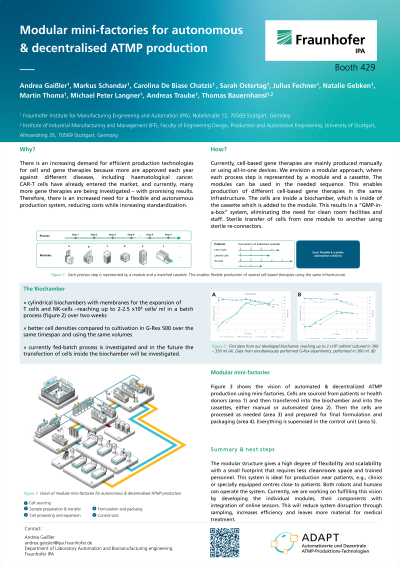Shaping the Future of Therapeutics
Poster Session A
(1068-A) Modular mini-factories for autonomous & decentralised ATMP production
Tuesday, May 28, 2024
16:30 - 17:15 CEST
Location: Exhibit Hall

- AG
Andrea Gaißler
Research Associate
Fraunhofer IPA
Stuttgart, Baden-Wurttemberg, Germany
Poster Presenter(s)
Abstract: Why?
There is an increasing demand for efficient production technologies for cell and gene therapies because more are approved each year against different diseases, including haematological cancer. CAR T cells have already entered the market, and currently, many more gene therapies are being investigated – with promising results. Therefore, there is an increased need for a flexible and autonomous production system, reducing costs while increasing standardization. Currently, cell-based gene therapies are mainly produced manually or using all-in-one devices.
How?
We developed a modular system structure for the production of cell and gene therapies. We separated the production process into individual steps; these steps are mapped onto modules. The modules operate the cassettes. By modularisation, the individual modules can be flexibly used as needed, enabling the simultaneous production of different kinds of cell-based gene therapies using the same infrastructure on a small footprint. The modules are occupied only during the individual process step; thereby, the process can be scaled up by amplifying the number of modules with longer process steps (e.g. cell expansion for about ten days).
The cells are inside a bio chamber, encapsulated in a cassette, resulting in a closed “GMP-in-a-Box” system. This eliminates the need for large clean room facilities and specially trained staff. The cassette holds everything needed for the process step (media, virus particles etc.). Furthermore, we developed bio chambers for the genetic modification and expansion of T and NK cells. First, results of the expansion chamber show promising results - reaching up to 2-2.5 x 106 cells/ml in a batch process – a fed-batch process is currently under investigation.
At the end of each process step, the cells must be transferred to the next cassette in a sterile manner. We have developed a sterile connector that enables cell transfer from one closed system to another.
What?
The modular structure gives a high degree of flexibility and scalability with a small footprint that requires less cleanroom space and trained personnel. This system is ideal for production near patients, e.g., clinics or specially equipped centres close to patients. Both robots and humans can operate the system, giving more flexibility in producing gene therapies as needed. Currently, we are working on fulfilling this vision by developing the modules and their components and planning to integrate online sensors. This will reduce system disruption through sampling and leave more material for medical treatment.
There is an increasing demand for efficient production technologies for cell and gene therapies because more are approved each year against different diseases, including haematological cancer. CAR T cells have already entered the market, and currently, many more gene therapies are being investigated – with promising results. Therefore, there is an increased need for a flexible and autonomous production system, reducing costs while increasing standardization. Currently, cell-based gene therapies are mainly produced manually or using all-in-one devices.
How?
We developed a modular system structure for the production of cell and gene therapies. We separated the production process into individual steps; these steps are mapped onto modules. The modules operate the cassettes. By modularisation, the individual modules can be flexibly used as needed, enabling the simultaneous production of different kinds of cell-based gene therapies using the same infrastructure on a small footprint. The modules are occupied only during the individual process step; thereby, the process can be scaled up by amplifying the number of modules with longer process steps (e.g. cell expansion for about ten days).
The cells are inside a bio chamber, encapsulated in a cassette, resulting in a closed “GMP-in-a-Box” system. This eliminates the need for large clean room facilities and specially trained staff. The cassette holds everything needed for the process step (media, virus particles etc.). Furthermore, we developed bio chambers for the genetic modification and expansion of T and NK cells. First, results of the expansion chamber show promising results - reaching up to 2-2.5 x 106 cells/ml in a batch process – a fed-batch process is currently under investigation.
At the end of each process step, the cells must be transferred to the next cassette in a sterile manner. We have developed a sterile connector that enables cell transfer from one closed system to another.
What?
The modular structure gives a high degree of flexibility and scalability with a small footprint that requires less cleanroom space and trained personnel. This system is ideal for production near patients, e.g., clinics or specially equipped centres close to patients. Both robots and humans can operate the system, giving more flexibility in producing gene therapies as needed. Currently, we are working on fulfilling this vision by developing the modules and their components and planning to integrate online sensors. This will reduce system disruption through sampling and leave more material for medical treatment.
